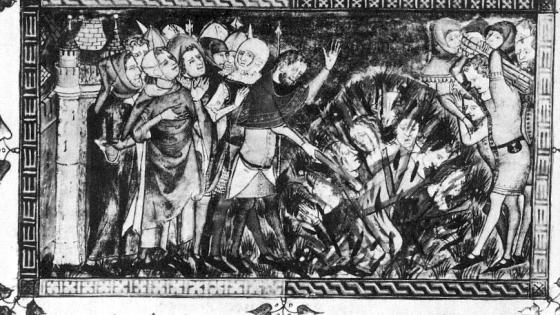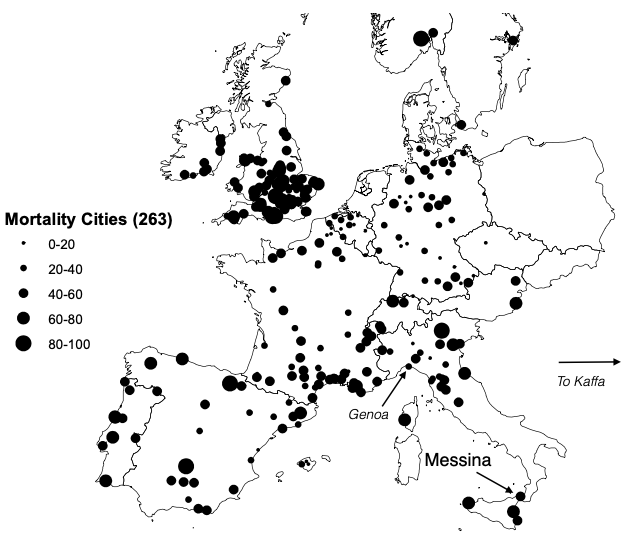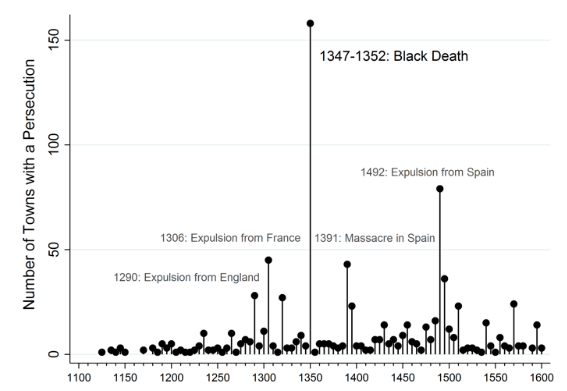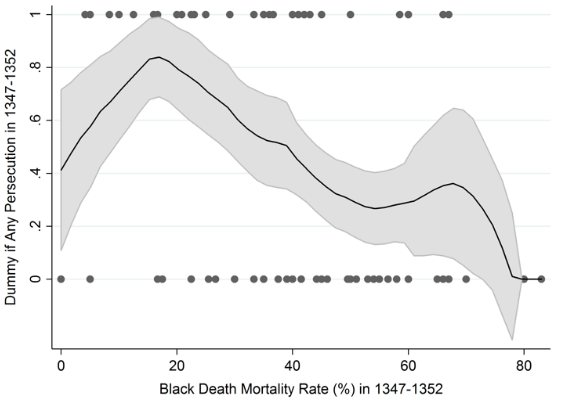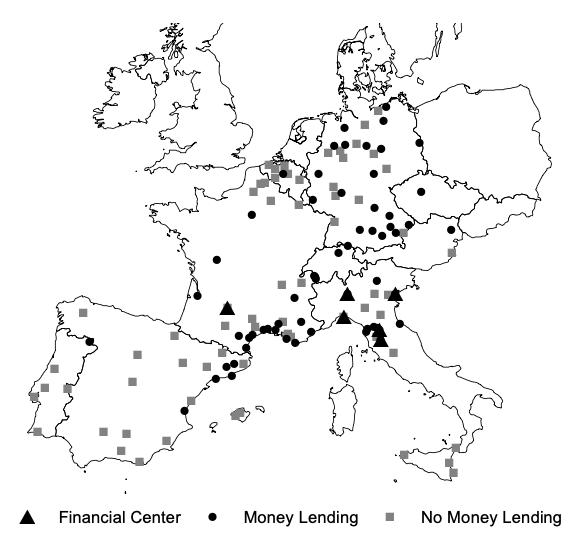During pandemics people often look for scapegoats. Amidst the current COVID-19 outbreak, there has been growing discrimination in western countries against Chinese and others communities of Asian descent. In Asian countries, immigrants and religious minorities have been blamed for the spread of the virus. For instance, in China, Africans and Caucasians have been targeted, while in India, Muslims are in danger. Similarly, in the Middle East, South-East Asians and East Africans have been singled out.
To find events comparable to the COVID-19 outbreak, one has to look back to history for events such as the 1918 Influenza (Aassve et al. 2020) or the outbreaks of plague that hit Europe during the 14th to 17th centuries (Cummins et al. 2020). Indeed, past epidemics have often seen minority groups become scapegoats (Cohn 2012).
Not all communities, however, persecuted their minorities when crises hit. What can explain this? In a recent paper, we address this question by investigating what caused cities to persecute their Jewish communities during the fourteenth century Black Death (Jedwab et al. 2019a).
Between 1347 and 1352, about 40% of the population of Europe died due to the Black Death. As shown in Figure 1, mortality rates across cities varied widely. Some cities, such as Zurich or Naples, were devastated, losing about two-thirds of their populations. Others, such as Milan and Prague, suffered significantly fewer deaths. This massive and heterogenous shock to populations had many effects, not the least of which was reshaping the urban system in Europe permanently (Jedwab et al. 2019b). However, one of the most well-known effects of the Black Death was that Jews across Europe were blamed for the disease and suffered one of the most devastating periods of persecution in history. On the eve of the Black Death, we estimate that there were 363 cities with Jewish communities across Europe. During the plague pandemic, half of these communities were either killed or expelled from their homes.
Figure 1 Black Death mortality rates
There are two competing forces to consider when attempting to explain why a community chose whether or not to persecute Jews. On the one hand, people may choose to scapegoat Jews for the disease. On the other, it is well known that in many towns Jews played a vital economic role in relatively high-skilled trades such as moneylending, trade, or medicine. If the value of these services were complementary to the non-Jewish community and if this value increased during troubled economic times, then we may observe Jews being protected more as mortality rates increase. This protective effect was especially likely given that many cities during this period relied on Jews for tax revenues (Johnson and Koyama 2019). When mortality increased, tax revenues declined, making Jews – and the economic services they provided – all the more valuable.
One of the peculiarities of the Black Death was that mortality rates across cities had a strong random component. Unlike some diseases whose spread and virulence is strongly correlated with population density and trade, the 14th century plague was rarely transmitted directly from person to person through coughing or touch, but rather spread through flea bites. Because of this, we are able use the plague as a sort of probe to investigate which of the two factors – scapegoating or economic complementarities – played a dominant role in determining the persecution probability of Jewish communities.
Figure 2
(a) Jewish persecutions over time
(b) Mortality rates and the probability of a persecution
Figure 2 shows what we found. Black Death mortality rates are on the horizontal axis and the probability that a Jewish community was persecuted is on the vertical axis. The first thing to notice is that there is definite evidence for scapegoating. Even with a mortality rate close to zero there was about a 40% chance that a community would be persecuted. As the mortality rate increases to 20% this probability also increases to 80%. However, as mortality rates climb past 20% the persecution probability starts to decrease. This is evidence for the economic complementarities effect. In fact, once the mortality rate is past 20% there is a stable one-for-one relationship between mortality and persecution probability – a 1% increase in mortality led to a one percent decrease in the chance of a persecution.
The results in Figure 2 are intriguing, but the 10% confidence interval around the estimated line suggests that there was significant heterogeneity across towns in their response to the shock. What were the city level forces that helped determine whether the scapegoating or the complementarities effect would dominate? Historians have noted that the economic importance of certain Jewish communities enabled them to weather persecutory storms. For example, in Regensburg, where moneylending to the merchants of the city was conducted on a large scale, the Jewish community survived the Black Death persecutions. Regensburg was also able to reach new heights of prosperity by offering asylum to rich Jewish refugees in the aftermath of the plague (Wasserman 2007). Similar motivations explain why leaders in Strasbourg, Basel, and Freiburg agreed that Jews should be protected from popular demands for persecution if this was at all possible.
Figure 3
(a) Moneylending centers
(b) Proxies of scapegoating
We test whether economic complementarities really did play a role in protecting Jews, by collecting data on whether or not Jews are mentioned as actually lending money in a city. These data are mapped in Figure 3(a). Since the protective effect should be strongest where there are no non-Jewish sources of moneylending to substitute for Jews, we also collect data on centers of non-Jewish finance in Europe, represented as triangles in Figure 3(a). As predicted, the protective effect of economic complementarities for Jews living in cities where moneylending is occurring increases by 50% relative to places without recorded banking activities. Similarly, if a city had a high potential for trade, measured, for example, as having high market access or being located near a major road or river, the protective effect increased. By contrast, when there were substitutes to Jewish moneylenders nearby, then the protective effect completely disappears – leaving only the scapegoating effect which increased the chance of a persecution.
What factors contributed to scapegoating? According to scapegoating theory, when members of a majority experience a shock, they may choose to blame a specific target in order to make sense of the traumatic event and increase their sense of power. One reason why Jews were scapegoated during the Black Death was because Christians believed they were poisoning wells and that this explained the death and misery overtaking them. Historians have identified the source for this particularly damaging, and false, rumour as Chillon Castle, located on the shores of Lake Geneva in Switzerland. The river Rhine also originates there, and it was a crucially important waterway, conveying not just goods and people, but information. We show that cities that were closer to Chillon Castle or to the Rhine River – that is, more embedded in the fake news network – were more likely to persecute Jewish communities (Figure 3b). In fact, for those cities, the protective effect was completely absent.
Another possible contributor to scapegoating was latent antisemitism which easily manifested as violence once the plague arrived (Voth and Voigtländer 2012). We collect data on cities with a history of persecuting Jews. For example, Figure 3(b) shows cities where Jews were accused of desecrating Christian symbols, or of ritual murder of non-Jews during the 13th or 14th centuries. Figure 3(b) also shows the locations of pogroms perpetrated by knights on their way to fight the First Crusade in 1096. For cities near these locations, the probability of a persecution was substantially higher and the protective effect was completely absent.
The likelihood of scapegoating was also affected by when the Black Death struck a city. If it arrived during a religious holiday that primed people towards antisemitism, then persecution was more likely. If people started getting sick around Easter – when medieval Christians were constantly being reminded that Jews played a role in the crucifixion of Christ – then Jewish communities were at greater risk. This was the unfortunate experience of Jewish communities in Munich, Valencia, and Grenoble, for example. By contrast, if the Black Death arrived in a town during Lent – when Christians were supposed to refrain from excessive food and drink and engage in self-reflection – Jews were less likely to be attacked.
We also explore whether cities that massacred their Jewish communities suffered a growth penalty. Such a penalty is suggested by contemporary sources which report cities resettling Jewish communities after the Black Death, specifically to replenish tax coffers and to rebuild the economy. Consistent with this, we find that cities that killed their Jewish communities during the Black Death bore the cost of this for centuries into the future as they grew, on average, 20% slower than cities that protected their valuable Jewish neighbours.
The experience of Jews during the Black Death highlights the dangers of fake news and latent racism in society. During times of crisis, fake news and racist sentiments easily morph into violence. The history of the Black Death also shows that one way to prevent such violence is to foster commercial ties between all groups in society. The trade creation and skills that Jewish communities brought to cities appear to have been important factors in recovery after the Black Death. This suggests that the observed attempts by governments today to close their economies to foreign goods and foreign workers because of COVID-19 might harm their future recovery.
References
Aassve, A, G Alfani, F Gandolfi and M L Moglie (2020), “Pandemics and social capital: From the Spanish flu of 1918-19 to COVID-19”, VoxEU.org, 22 March.
Cohn, S K (2012), “Pandemics: waves of disease, waves of hate from the plague of Athens to Aids”, Historical Research 85(230): 535–555.
Neil C, M Kelly and C Ó Gráda (2020), “Coronavirus from the perspective of 17th century plague”, VoxEU.org, 21 April.
Jedwab, R, N D Johnson and M Koyama (2019a), ‘Negative shocks and mass persecutions: evidence from the Black Death’, Journal of Economic Growth 24(4): 345–395.
Jedwab, R, N Johnson and M Koyama (2019), “Pandemics, Places, and Populations: Evidence from the Black Death”, CEPR Discussion Paper 13523.
Johnson, N D and M Koyama (2019), Persecution & toleration: The long road to religious freedom, Cambridge University Press.
Voigtländer, N and H-J Voth (2012), “Persecution Perpetuated: The Medieval Origins of Anti-Semitic Violence in Nazi Germany”, The Quarterly Journal of Economics 127(3): 1339–1392.
Wasserman, H (2007), "Regensburg", in M Berenbaum and F Skolnik (eds), Encyclopedia Judaica, Vol. 17, Macmillan Reference, New York, pp. 188–189.
Endnotes
1 https://www.cnn.com/2020/04/22/us/new-york-coronavirus-discrimination-harassment-response-team/index.html
2 https://www.theguardian.com/world/2020/mar/29/china-coronavirus-anti-foreigner-feeling-imported-cases
3 https://www.aljazeera.com/programmes/insidestory/2020/04/coronavirus-africans-china-targeted-200413185723311.html
4 https://www.cnn.com/2020/04/23/asia/india-coronavirus-muslim-targeted-intl-hnk/index.html
